Students can Download 1st PUC Basic Maths Model Question Paper 8 with Answers, Karnataka 1st PUC Basic Maths Model Question Papers with Answers helps you to revise the complete syllabus.
Karnataka 1st PUC Basic Maths Model Question Paper 8 with Answers
Time: 3.15 Hours
Max. Marks: 100
Instructions:
- The questions paper consists of five parts A, B, C, D, and E.
- Part – A carries 10 marks, Part – B carries 20 marks, Part – C curries 30 marks, Part – D carries 30, and Part – E carries 10 marks.
- Write the question numbers properly as indicated in the questions paper
PART-A
I. Answer any TEN questions. (10 × 1 = 10)
Question 1.
Write the real part of 2 + 3i.
Answer:
2.
Question 2.
If A = {a, b, c, d}, B = {a, b, c} find A n B.
Answer:
A∩B = {a, b, c}.
Question 3.
Simplify : (3°)2 + (32)°.
Answer:
(1)2 + (9)°= 1 + 1= 2.
Question 4.
Find the value of log10 1000
Answer:
log10 1000 = log10 103 = 3 log10 10 = 3(1) = 3
Question 5.
Find the 8th term of the A.P. 2, 4, 6………….
Answer:
a = 2, d = 2 ,n = 8, T8 = ?
Tn = a + (n – 1)d
= 2 + (8 – 1) (2) = 2 + 7 (2) = 2 + 14 = 16
![]()
Question 6.
Solve for x : 2 (- 8 + x) = 28 – 2x
Answer:
– 16 + 2x = 28 – 2x
2x + 2x = 28 + 16
4x = 44 ⇒ x = 11
Question 7.
Find the S. I. on Rs. 500 at 5% for 5 years.
Answer:
SI = \(\frac{500 \times 5 \times 5}{100}\) = 25 × 5 = 125
Question 8.
Define perpetuity.
Answer:
If the installments (annuities) are made for an infinite period them it is called a perpetuity.
Question 9.
Convert 0.25 into persentage.
Answer:
0.25 = 0.25 × 100% = \(\frac{25}{100}\) × 100% = 25%.
Question 10.
Convent 45° into radians.
Answer:
45° =45 × \(\frac{\pi}{180}=\frac{\pi}{4}\)
Question 11.
Find the value of Sin260° + Cos260°.
Answer:
Sin2 60 +Cos2 60 = 1.
![]()
Question 12.
Find the locus of a point that moves such that its distance x-axis is 5.
Answer:
y = 5
PART-B
II. Answer any TEN of the following questions: (10 x 2 = 20)
Question 13.
Find the number of positive divisors of 360
Answer:
360 = 2 × 32 × 51
= p1α1 × p2α2 × p3α3
T(a) = (1 + α1)(1 + α2)(1 + α3)
T(360) =(1 + 3)(1 + 2)(1 + 1)
= (4)(3)(2) = 12(2) = 24.
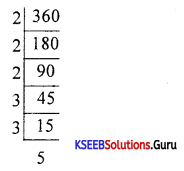
Question 14.
Find the L.C.M. of 9, 15 and 24.
Answer:
9 = 32
15 = 3 × 5
24 = 23 × 31
LCM = 23 × 32 × 51 = 8 × 9 × 5 = 360.
Question 15.
If u= {1, 2, 3, ……….. 9}, A = {1, 2, 3, 4, 5}, B = {3, 4, 5, 6, 7} then verify (A ∪ B)’ = A’ ∩ B’
Answer:
A∪B = {1, 2, 3, 4, 5, 6,7} (A∪B)’ = {8,9}
A’ = {6, 7, 8, 9} B’ = {0, 2, 8, 9} A’∩B’ = {8,9}
∴ A (A∪B)’= A’∩B’
Question 16.
If K + 9, – 6 and 4 are in GP., then find the value of K.
Answer:
(- 6)2 = (K + 9)4
36 = 4K + 36
⇒ 4K = 0
K = 0.
![]()
Question 17.
If α and β are the roots of the equation x2 + 5x + 6 = 0. Then find the value of \(\frac{\alpha}{\beta}+\frac{\beta}{\alpha}\)
Answer:
α + β = 5 αβ = 6
\(\frac{\alpha}{\beta}+\frac{\beta}{\alpha}=\frac{\alpha^{2}+\beta^{2}}{\alpha \beta}=\frac{(\alpha+\beta)^{2}-2 \alpha \beta}{\alpha \beta}=\frac{25-12}{6}=\frac{13}{6}\)
Question 18.
Find two numbers whose sum is 64 and the difference is 16.
Answer:
x + y = 64
x – y = 16
2x + 80
⇒ x = 40
x + y – 64
40 – y = 64
y = 64 – 40 = 24
y = 24
Question 19.
Sove the following linear inequality: 5x – 3 < 3x + 1, x ∈ real numbers. Also represent it on a number line.
Answer:
5x – 3 < 3x + 1
5 x – 3x < 3 + 1
2x < 4 ⇒ x < 2 or x ∈ (-∞, 2)
![]()
Question 20.
The average score of 40 boys is 60% and an average of 60 girls is 70%. Find the combined average of boys and girls.
Answer:
N1 = 40 X1 = 60% N2 = 60 X2 = 70%
X̄12 = \(\frac{\mathrm{X}_{1} \mathrm{~N}_{1}+\mathrm{X}_{2} \mathrm{~N}_{2}}{\mathrm{~N}_{1}+\mathrm{N}_{2}}=\frac{60(40)+70(60)}{40+60}\)
\(\frac{2400+4200}{100}=\frac{6600}{100}\)
= 66
Question 21.
Find the value of: Sin2 \(\frac{5 \pi}{6}\) + cos2 \(\frac{5 \pi}{6}\) – tan2\(\frac{ \pi}{4}\)
Answer:
Sin 5π/6 = Sin 150 = Sin (180-30) = Sin 30 = 1/2
Cos 5π/6 = Cos 150 = Cos (180-30) = -Cos 30 = –\(\)
tan π/4 = tan 45 = 1
LHS = (1/2)2 – (-3/2)2 – 12
= 1/4 + 1/3 – 1 = \(\frac{1+3-4}{4}=\frac{0}{4}\) = 0
Question 22.
Find the value of x, if the distance between (x, 3) and (4, 5) is 5 units.
Answer:
\(\sqrt{(x-4)^{2}+(3-5)^{2}}\) = 5
(x – 4)2 + 4 = 25
x2 – 8x+ 16 + 4-25 = 0
x2 – 8x – 5 = 0
= \(\frac{8 \pm \sqrt{64-4(1)(-5)}}{2(1)}=\frac{8 \pm \sqrt{84}}{2}\)
= \(\frac{8 \pm 2 \sqrt{21}}{2}\)
x = 4 ± \(\sqrt{2}\).
![]()
Question 23.
Find the locus of a point that moves such that it is equidistant from (5, 0) and (-5, 0).
Answer:
P = (x, y) A = (5, 0) B = (- 5. 0)
PA = PB
PA2 = PB2
(x – 5)2 + y2 = (x + 5)2 + y2
![]()
20 x = 0 ⇒ x = i.e., y – axis
Question 24.
Find the equation of a straight line passing through (3, 4) and having a slope of 3.
Answer:
y – 4 = 3 (x – 3)
y – 4 = 3x – 9 ⇒ 3x – y – 5 = 0.
Question 25.
Derive the equation of the straight line passing through two points (x1, y1) and (x2, y2).
Answer:
Let P (x, y) be any point an the line joining points A (x1, y1) and B(x2, y2)
∴ APB are collinear
The slope of AP = Slope of AB
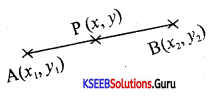
\(\frac{y-y_{1}}{x-x_{1}}=\frac{y_{2}-y_{1}}{x_{2}-x_{1}}\) (Two Point form)
PART – C
III. Answer any ten questions : (10 × 3 = 30)
Question 26.
Prove that \(\sqrt{2}\) is not a rational number.
Answer:
We shall prove it by the method ofcontradiction.
If possible Let \(\sqrt{2}\) be a rational number
Let \(\sqrt{2}\) = \(\frac{p}{q}\) where p and q are Integers and q ≠ 0.
Further let p and q are coprime i.e. H.C.F. of p and q = 1.
\(\sqrt{2}\) = \(\frac{p}{q}\) ⇒ \(\sqrt{2}\)q = p
⇒ 2q2 = p2
⇒ 2 divides p2 ⇒ 2 divides p
⇒ p is even
Let p = 2k where k is an integer p2 = 4k2
2q2 = 4k2
q2 = 2k2 ⇒ q2 is even
⇒ q is even.
Now p is even and q is even which implies p and q have a common factor 2. which is a
contradiction of the fact that p and q are co-prime.
∴ our assumption that \(\sqrt{2}\) is rational is wrong and hence \(\sqrt{2}\) is irrational.
Question 27.
If R-1 = {(2, 4), (1, 2), (3, 1), (3, 2)}, find R. Also find its domain and range.
Answer:
R = {(4, 2), (2, 1), (1, 3), (2, 3)}
Domain of R= {1, 2, 4}
Range of R= {1, 2, 3}.
Question 28.
If ax = by = cx and b2 = ac show that \(\frac{1}{x}+\frac{1}{z}=\frac{2}{y}\)
Answer:
Let ax = by = cz = k (say)
∴ ax = k ⇒ a = k1/x, by = k ⇒ b = k1/y, cz = k ⇒ c = k1/z
Now, b2 = ac
∴ (k1/y)2 = k1/x. k1/z
∴ k2/y = k1/x+1/z
Bases are the same ∴ Equating powers on both sides, we get.
\(\frac{1}{x}+\frac{1}{z}=\frac{2}{y}\)
Question 29.
Prove that \(\frac{1}{\log _{2} 4}+\frac{1}{\log _{8} 4}+\frac{1}{\log _{16} 4}\) = 4.
Answer:
LHS = \(\frac{1}{\log _{2} 4}+\frac{1}{\log _{8} 4}+\frac{1}{\log _{16} 4}\) = log 42+ log4 8+ log4 16
= log4 2. 8 .16 = log4 256 = log4 44 = 4 log4 4 = 4(1) = 4 = RHS.
![]()
Question 30.
The sum of three numbers in an A.P. is 15 and their product is 105. Find the numbers.
Answer:
Let the numbers be a – b, a, a + d
(a-d) + a + (a + d)= 15
3a= 15
a = 15/3 = 5
(a – d) a (a + d) = 105 .
(5 – d)5(5 + d) = 105
(5 – d)(5 + d) = \(\frac{105}{5}\)
25 – d2 = 21
25 – 21 = d2 ⇒ d2 = 4
⇒ d = ±2
Let d = 2
∴ The numbers are
5-2, 5, 5 + 2
3, 5, 7.
Question 31.
If sum of the digits of a two digit numbers is 9 and if 9 is added to the number, then the digits get reversed.
Answer:
Let the number be 10x + y, x + y = 9
10x + y + 9 = 10y + x
9x – 9
y = – 9

x = 4
y = 5
∴ The number in 10 x +y = 10 (4) + 5 = 40 + 5 = 45.
Question 32.
In what time, a sum of Rs. 500 will earn Rs. 975 at the rate of 6% p.a. if C. 1 is payable half yearly
Answer:
P = 500 CI = 975
A = P + CI = 500 + 975 = 1475
R = 6% = 0. 06 (Nominal rate of interst)
9 = 2
r = \(\left(1+\frac{R}{q}\right)^{q}\) – 1
= \(\left(1+\frac{0.06}{2}\right)^{2}\) – 1
= 0. 0609 = 6. 09 %
r= 0. 0609
A + P (1 + r)n
log A= log P + n log (1 + r)
n = \(\frac{\log \mathrm{A}-\log \mathrm{P}}{\log (1+r)}\)
= \(\frac{\log 1475-\log 500}{\log 1.0609}\)
= \(\frac{3.1688-2.6990}{0.0253}\)
n = 18. 56 years.
Question 33.
By how much should the use of tea be decreased if the Price of tea is increased by 25% so that the expenditure remains unchanged.
Answer:
Let the Price be 100 Let the quantity be 100
Total expenditure = 100 × 100 = 10,000
New Price = 100 + 25 = 125
Let the new quantity be y
Total Expenditure = 125 y
∴ 125 y = 1000
y = 80 ∴ Decrease on quantity = 100 – 80 = 20
% decrease = \(\frac{\text { Decrease }}{\text { Original Value }}\) × 100%
= \(\frac{20}{100}\) x 100%
= 20%.
Question 34.
Find the B.E.P in units if total cost and the revenue functions are C(x) = 450 + 1. 5JC and R(x) = 3x. (x = level of out put).
Answer:
At Break Even point,
Total revenue = Total cost
∴ R (x) = C(x)
3x = 450 + 1.5x
3x – 1.5x = 450
1.5x = 450
∴ x = \(\frac{450}{1.5}\)
x = 300 units.
Question 35.
If cot A = \(\frac{5}{12}\) and A is acute show that 2 cosec A – 4SecA = – \(\frac{247}{30}\)
Answer:
cot A = \(\frac{5}{12}\)
cosec A = \(\frac{13}{12}\)
sec A = \(\frac{13}{5}\)
2 cosec A – 4SecA = 2.\(\frac{13}{12}\) – 4.\(\frac{13}{5}=\frac{26}{12}-\frac{52}{5}=\frac{130-624}{60}=\frac{-494}{60}=-\frac{247}{30}\)
![]()
Question 36.
If A, B, C are angles of a triangle then prove that.
(i) Sin (A + B) = SinC
(ii) Cos \(\left(\frac{\mathbf{A}+\mathbf{B}}{2}\right)\) = Sin\(\frac{C}{2}\)
Answer:
(i) Sin (A + B) = Sin (180 – C) = Sinc
(ii) Cos\(\left(\frac{\mathbf{A}+\mathbf{B}}{2}\right)\) = Cos\(\left(\frac{180-C}{2}\right)\) = Cos(90 – \(\frac{C}{2}\))
= Sin\(\frac{C}{2}\)
Question 37.
Show that the points A(2, 2), B(6, 3) and C (4, 11) form a right angled triangle.
Answer:
AB = \(\sqrt{(6-2)^{2}+(3-2)^{2}}=\sqrt{16+1}=\sqrt{17}\)
BC = \(\sqrt{(4-6)^{2}+(11-3)^{2}}=\sqrt{4+64}=\sqrt{68}\)
CA = \(\sqrt{(4-2)^{2}+(11-2)^{2}}=\sqrt{4+81}=\sqrt{85}\)
AB2 = 17 BC2 =68 CA2 =85
∴ AB2 + BC2 = CA2
∴ ABC form a right angled triangle
Question 38.
Find the distance between the parallel lines : 3x + 4y + 5 = 0 and 6x + 8y + 20 = 0.
Answer:
6x + 8y + 10 = 0
6x + 8y + 20 = 0.
d = \(\left|\frac{\mathrm{C}_{1}-\mathrm{C}_{2}}{\sqrt{a_{2}+6_{2}}}\right|=\left|\frac{10-20}{\sqrt{6^{2}+8^{2}}}\right|=\left|\frac{-10}{10}\right|\) = |-1| = 1 units
PART – D
IV. Answer any six questions : (6 × 5 = 30)
Question 39.
Out of 50 people, 20 drink tea and 10 take both tea and coffee. How many take at least one of the two drinks. Also, represent the above problem by Venn diagram.
Answer:
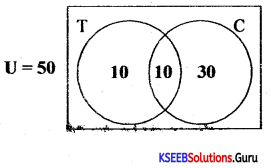
n(T∪C) = n(T) + n(C) – n(T∩C)
50 = 20 + n(C) – 10
40 = n(C)
Number of people taking atleast one of the two drinks 10 + 10 + 30 = 40 + 10 = 50.
Question 40.
Find the value of the following using logarithmic table. \(\frac{213.781 \times 7.434}{6.321}\)
Answer:
Let x = \(\frac{213.781 \times 7.434}{6.321}\)
logx = log\(\left[\frac{213.781 \times 7.434}{6.321}\right]\)
= log213.781 + log 7.434 – log 6.321
= 2.3298 + 0.8712 – 0.8008.
= 2.4002
x = Antilog 2.4002
x = 251.3.
Question 41.
Find the sum of all the numbers betw een 50 and 200 which are divisible by 11.
Answer:
S = 55 + 66 + 77 +……………….+ 198
55, 66, 77, …………….198
Here a = 55, l = Tn = 198, d= 11
Now, Tn = a + (n – 1) d
198 = 55 + (n – 1) 11
198 – 55 = (n – 1) 11
2\(\frac{143}{11}\) = n – 1
n – 1 = 13
n= 13 + 1
n= 14
Now consider:
Sn = \(\frac{n}{2}\)(a + l)
S14 = \(\frac{14}{2}\)(55 + 198)
= 7(253)
= 1,771.
Question 42.
Find the integral roots between – 3 and + 3 by inspection and then using synthetic division, solve the equation.
x3 – 2x2 – 5x + 6 = 0.
Answer:
Let f (x) = x3 – 2x2 – 5x + 6
f(1)= 1 – 2 – 5 + 6 = 7 – 7 = 0
∴ x = 1 is a root of the given equation by using Synthetic division.

The resulting equation is x2 – x – 6 = 0 is the quotient and remainder = 0
x2 – x – 6 = 0
(x – 3) (x + 2) = 0
x = 3 or – 2
Thus x = 1, -2, 3 are the roots of the given equation.
![]()
Question 43.
Find the difference between S. 1. and C. 1. on Rs. 18000 invested for four years at 8% p.a. where C. 1. is compounded annually.
Answer:
Simple Interest .
P= 18,000
T = 4
R = 4
SI = \(\frac{\text { PTR }}{100}\)
= \(\frac{18,000 \times 4 \times 8}{100}\)
= ₹ 5,760
Compound Interest
P = 18,000
n = 4
I = 0.08
A = P(1 + i)n
= 18,000(1 +0.08)4
= 24,488.8
CI = A – P
= 24,488.8 – 18,000
CI = 6488.8
Difference between Cl and SI is
CI – SI = 6488.8 – 5760
= 728.8.
Question 44.
Find the present value of an annuity of Rs. 2500 payable at the end of 6 months for 5 years, if money is worth 10% computed semi-annually.
Answer:
a = 2500
i = \(\frac{0.10}{2}\) = 0.05
n = 5 x 2 = 10
P = \(\frac{a\left[(1+i)^{n}-1\right]}{i(1+i)^{n}}\)
= 2500\(\frac{\left[(1+0.05)^{10}-1\right]}{0.05(1+0.05)^{10}}\)
= \(\frac{2500[1.6289-1]}{0.05 \times 1.6289}\)
= ₹ 19304.44.
Question 45.
A watch is sold for Rs. 150 at a profit of 25%. At what price should it be sold in order to have 50% profit.
Answer:
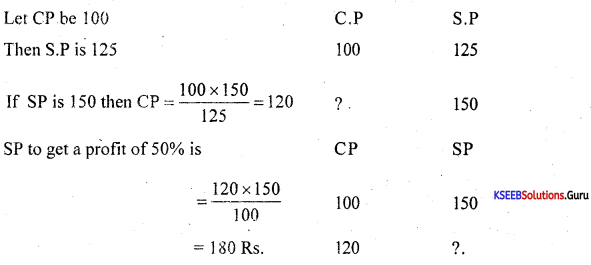
Question 46.
Prove that: \(\frac{\tan A}{1-\cot A}+\frac{\cot A}{1-\tan A}\) = 1 + Sec A. Cosec A.
Answer:
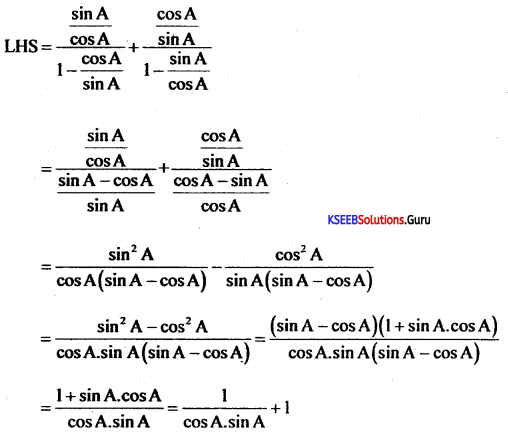
= sec A . cosec A + 1 = R.H.S.
Question 47.
Show that the following points are the vertices of a square A (1, 1), B (4, 1),C(4, 4) and D (1, 4)
Answer:
AB = \(\sqrt{(4-1)^{2}+(1-1)^{2}}=\sqrt{9+0}\) = 3
BC = \(\sqrt{(4-4)^{2}+(4-1)^{2}}=\sqrt{0+9}\) = 3
CD = \(\sqrt{(1-4)^{2}+(4-4)^{2}}=\sqrt{9+0}\) = 3
DA = \(\sqrt{(1-1)^{2}+(4-1)^{2}}=\sqrt{0+9}\) = 3
AB = BC = CD + AD
Sol.
AC = \(\sqrt{(4-1)^{2}+(4-1)^{2}}=\sqrt{9+9}=\sqrt{18}\)
BD = \(\sqrt{(1-4)^{2}+(4-1)^{2}}=\sqrt{9+9}=\sqrt{18}\)
∴ AC = BD
ABCD ∆ is a Square.
![]()
Question 48.
Find the area of a quadrilateral whose vertices are A(1, 1), B (4, 1), C (4, 4), and D (1, 4).
Answer:
The required area ABCD = area of the triangle ABC + area of triangle ACD
Area of the triangle ABC = \(\frac{1}{2}\)[1(-3 – 2) + 7(2 -1) + 12(1 + 3)]
= 25 sq. units
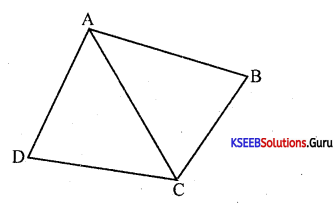
Similarly
Area of the triangle ACD =107 sq.units
Area of the triangle ABCD = 25 + 107 = 132 sq.units.
PART – E
V. Answer any one questions : (1 × 10 = 10)
Question 49.
(a) If f(x) = x + 1 and g(x) = x2 + 1.
Find (i) fog (1), (ii) fog (2), (iii) gof (1), (iv) gof (2), (v) fog (3)
Answer:
f(x) = x+ 1 and g (x) = x2 + 1
(i) fog (1) = f (g (1))
= f(2)
= 2 + 1 = 3
(ii) fog (2) = f (g(2))
= f(5)
= 5 + 1
= 6
(iii) gof(1)
= g(f(1))
= g(2)
= 4 + 1
= 5
(iv) gof (2)
= g(f(2))
=g(3)
= 9 + 1
= 10
(v) fog (3) f(g(3))
f (10) = 10 + 1
= 11.
(b) Find the sum to n terms of series
7 + 77 + 777 +………………n term.
Answer:
Let S = 7 + 77 + 777 + ………….. n terms
= 7 [1 + 11 + 111 +……………….to nterms] = \(\frac{7}{9}\)[9 + 99 + 999 + …………to n terms]
= \(\frac{7}{9}\)[ [(10 – 1) + (100 – 1) + (1000 – 1) + ………………to n terms]
= \(\frac{7}{9}\)[ [(10 + 102 + 103 + ……………… to n terms) – (1 + 1 + 1 ………………. to n terms] 9
= \(\frac{7}{9}\left[\frac{10\left(10^{n}-1\right)}{10-1}-n\right]\) [∵ 10 + 102 + 103 + ……. to n terms in GP where a = 10, r = 10]
Sn = \(\frac{7}{9}\left[\frac{10\left(10^{n}-1\right)}{9}-n\right]\)
(c) Find the number of digits in 320.
Answer:
(a) 320
Let x = 320
log x = log 320 = 20 log 3 = 20 (0.4771) = 9.542
As the characterstic is 9, number of digits = 9 + 1 = 10.
![]()
Question 50.
(a) Solve the following inequalities graphically
x + 2y ≤ 8
2x + y ≤ 8
x ≥ 0
y ≥ 0
Answer:
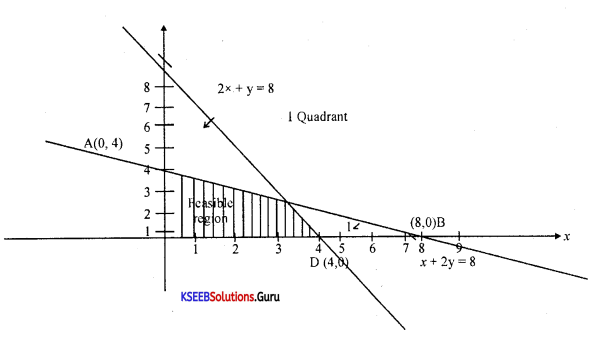
(b) Find the future value of an annuity of Rs. 500 at 5% p.a. payable for 5 years.
Answer:
A = 500 r = 5% =0.05 n = 5
F = \(\frac{\mathrm{A}\left[(1+r)^{n}-1\right]}{r}\)
= \(\frac{500\left[(1+0.005)^{5}-1\right]}{0.05}\)
\(\frac{500\left[(1 \cdot 05)^{5}-1\right]}{0 \cdot 05}\) = 2762.81
(c) Find the quadratic equation whose roots are 2 and 5.
Answer:
(x – 2) (x – 5) = 0
x2 – 2x – 5x + 10 = 0
x2 – 7x + 10 = 0.